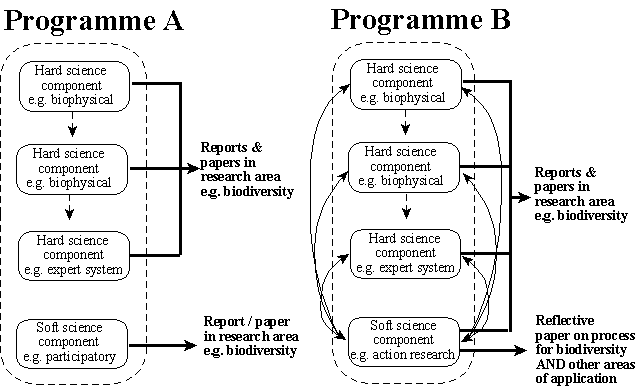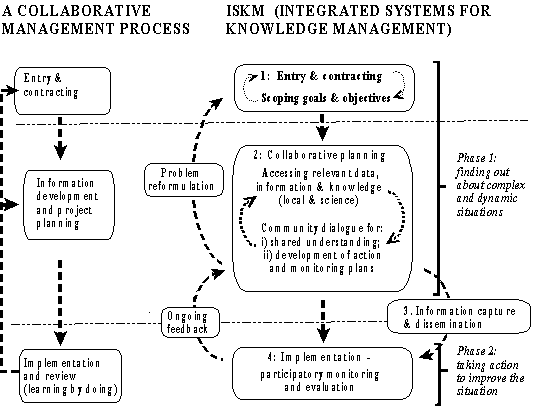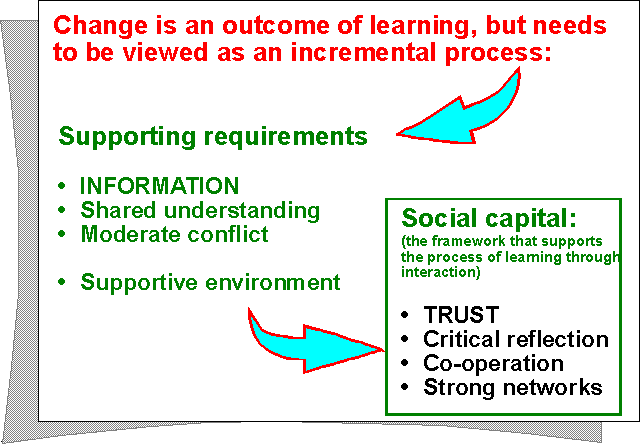CHAPTER 11
The need to link 'soft' and 'hard' research activities within multi-disciplinary
science teams
[Chapter 11 in: Allen, W.J. (2001) Working together for environmental management: the role of information sharing and collaborative learning. PhD (Development Studies), Massey University.]
|
Time period in which main work on this issue carried out: | |||||||||||
| Jul- 94 | Jan- 95 | Jul- 95 | Jan- 96 | Jul- 96 | Jan- 97 | Jul- 97 | Jan- 98 | Jul- 98 | Jan- 99 | Jul- 99 | Jan- 00 |
Allen, W.J. & Kilvington, M.J. (1999) Why involving people is important: The forgotten part of environmental information system management. Paper presented at 2nd International Conference on Multiple Objective Decision Support Systems for Land, Water and Environmental Management (MODSS '99) Brisbane, Australia, 1- 6 August 1999.
The importance of ensuring that the 'participatory' component of a science programme is integrally linked with other aspects of the research, and that the outcomes of stakeholder involvement are fed into the research design to influence subsequent activities and strategies is discussed. It is also suggested that the value of such participatory work can be increased if it is implemented as action research; this can also help to derive more generic lessons for environmental management. Learning is observed to not only require relevant and timely information, but also processes for developing shared understanding, managing moderate conflict and providing a supportive environment. Case studies are used to outline a useful role for action research practitioners within multi-disciplinary research teams. These show that efforts to share information need to build trust and confidence between information providers and users if they are going to be successful.
Aids and learning processes need to be considered together, yet here there is a problem. The scientists involved in developing decision support aids -- principally from the physical, natural and 'hard' social sciences -- are often isolated from those concerned with learning and participatory processes, who come primarily from the 'softer' social sciences ... The isolation is evident in the concepts and theories that each employs. It is also deepened by institutional barriers, between programs and organizations, which impede the level of collaboration needed. Such barriers may also weaken links between those involved in the design of aids and processes and those who make them available to wider user groups in the apprenticeship phase. (Loevinsohn et al. 1999).
As indicated in Figure 6.1, an important aspect of 'good practice' in participatory ecological research initiatives is that the 'participatory' or 'action research' component of the science programme is integrally linked with other aspects of the research, and that the outcomes of stakeholder involvement are fed into the research design to influence subsequent activities and strategies. While the tussock grasslands case study referred to in this thesis clearly shows we are still learning what is involved in doing this, it can also point to evidence that this mutual reinforcement of 'softer' participatory and 'harder' ecological science is happening.
For example, the observations by farmers in the initial HMP programme regarding the effects of different grazing regimes on Hieracium spp. led directly to the establishment of more targeted research experiments. Similarly, as this chapter paper highlights, during the subsequent Tussock Grasslands Research Programme, participatory conflict approaches were used to allay farmer concerns over the use of research results gained from sites on private land. The outcome of these discussions, in turn, led to a programme management decision to formalise a more community-based approach to research dissemination, as outlined in this extract from the ensuing e-mail to programme staff.
The traditional approach of researchers (doing) experiments, analysing and interpreting data, and publishing it in journals, does not on its own change end-user behaviour. In many cases this can result in making people distrustful of the motives and objectivity of science. To use this approach, especially in the complex and politically-loaded field of resource management where conflicting ideas and beliefs often exist between different stakeholders, may make it become increasingly difficult to do our science. ... We want our research to change behaviour "on the ground" (i.e. outcome-orientated research), but this has to involve the different stakeholders (e.g., Farmers, DOC, policy makers) in this process. We will not release data and information before it has been debated and interpreted within an environment where the relevant stakeholders are given the opportunity to appreciate one another's perspective. This community dialogue will not only help with the technology transfer process, but also with encouraging appropriate use of data and information from all perspectives. (Bosch 1998).
However, while this need to link participatory outcomes with other research activities may seem fairly obvious, in some projects the participatory component remains detached from other parts of the project. As McAllister (1999 p. 6) and Loevinsohn et al. (1999) in the opening quote to this chapter observe, this is particularly true for technically oriented projects. McAllister goes on to note a number of concerns that arise for action research practitioners because of the assumption that a lone participatory component is enough to fulfil the social science requirement.
Such an assumption fails to recognise the limitations of "quick and dirty" participatory methods and the potential for these to misrepresent or simplify complex social realities. In addition, the concept of participation has been used to 'get local people to do what researchers or project leaders want', rather than as a means for involving local people in project design and strategy (Goebel 1998:279). Another concern is that participatory research becomes 'tool' or 'approach' driven, with more emphasis placed on the application of different methods and approaches (PRA, PAR, multi-stakeholder analysis, etc.) than on the problems that the research is trying to address, and how these approaches can be best used to address them. (McAllister 1999 p. 6).
Certainly, there are increasing numbers of good examples of integrated research emerging, but McAllister's comments certainly do not appear to be related to rare instances. Moreover, this divorce of participatory components from other more technical research components creates particular problems, which work against the successful use of action research within science-based research and development initiatives. The first is that the output of such participatory exercises (see Figure 11.1, Programme A) are merely seen as another way of producing a paper or output that describes some aspect of the situation under inquiry (e.g. biodiversity).
While this will probably be related to the 'human dimension', its use in practice is likely to be limited because it does not link back into research implementation. Moreover, because its value is seen as low by programme leaders -- after all, they do not use it within the programme -- the time and resources allocated to the human dimensions component are often limited. In turn, both of these factors mean that the plan and reflect components of the action research cycle are often neglected, and consequently the wider process lessons that can be gained from such exercises for use in other situations are not developed.

Figure 11.1 Different ways in which research programmes do (Programme B), or do not (Programme A), integrate participatory components to complement more 'hard' or technical components.
However, in more integrated programmes (see Figure 11.1, Programme B), the participatory component will be viewed as complementary to, and reinforcing of, other more technical components. By helping integrate different viewpoints and foster involvement, such participatory components can build a social environment in which there is more interest and ownership in the results of the research. Furthermore, such research can most usefully contribute if it is undertaken within an action research framework, which is itself geared towards successful implementation. This, in turn, will not only contribute to the joint development of improved understanding and insights in the particular project in question (e.g. enhancing biodiversity), but can also lead to an improved understanding of the wider processes that are required to successfully involve people in such a collaborative exercise.
However, successful action research needs the development of a climate which is conducive to learning and change. This in turn is helped greatly by programme leadership which can put the 'change and learning project' on the agenda and keep it there, and ensure that the strategy for doing this is expressed in operational and actionable terms. Moreover, lower levels of leadership need to be similarly enthusiastic about their (and their staff's) participation within the action research initiative. Ideally then, this requires senior members of the research team to have the desirable characteristics required for their involvement as action research co-researchers outlined in Chapter 3 (Table 3.2). These include being open, self-reflective and strategic.
If carried out successfully, however, an action research approach will provide a wider set of process lessons, which can be made publicly available to help people better undertake similar collaborative endeavours in other areas, and with other environmental issues. By extension, even more valuable and robust lessons can be gained by sharing reflections across programmes and projects. The need for doing this is supported by Ledford and Mohrman (1993 p.168) who point out that learning from single cases is problematic. They go on to say, 'cross-case analysis is better than single case studies for understanding the variety of forms the intervention can take, shedding light on implementation issues, and increasing confidence in the external validity of findings'. While this may require extra effort and resources, the results can be well worth it as Ravetz points out:
A topic like this, which involves reflecting on a field of practice rather than doing it, can be looked at in two ways. One view is to consider it an irrelevance, or at best an excursion from the real work of the disciplined study. Such a dismissal is the common view among practitioners in most science-based disciplines. The other view is to say that in the absence of such reflections, the discipline is in danger of losing contact with its supposed tasks, and eventually also in danger of losing its clientele. Then such a reflection is considered as an 'added value' activity; although it must be undertaken outside the ordinary routine of practice, it eventually brings benefits to practitioners and to their clients as well. (Ravetz 1997 p.4).
The accompanying chapter paper, then, should be seen against this background. It represents an attempt to reflect on the lessons learnt across a number of participatory endeavours that have been undertaken in Landcare Research over recent years. It begins by briefly reviewing the need for collaborative learning within environmental management. A three-stage process for involving people in such collaborative approaches is outlined, involving: i) entry and contracting; ii) developing information for decision making; and iii) implementation and review. These can be mapped onto the ISKM process as shown in Figure 11.2. How, action research skills (relationship building, facilitation, conflict management, etc.) can then be used to support each of these stages is illustrated with the use of case study examples. These case studies include the tussock grasslands and black stilt ones introduced earlier in this thesis.

Figure 11.2 Different phases of involving people in the ISKM framework for managing environmental information for decision making.
The steps in ISKM provide a learning process through which many viewpoints and sources of information can be shared among the different parties involved, and integrated to find solutions that will guide the way forward. The iterative nature of the programme also encourages adaptive management.
While relevant and timely information is noted as key to such learning occurring, it is also pointed out that some supporting social processes that are required for this to happen. These include forums to develop a shared understanding around issues, managing a climate of moderate conflict and providing a supportive environment. The supportive environment required is one that is characterised by the elements of social capital referred to in the Chapter 9 reflections section. The linked nature of these social processes is illustrated below in Figure 11.3.

Figure 11.3 Social processes that must support information if learning is to occur (developed by Allen & Kilvington).
In turn, this suggests that if information (e.g. such as that developed in a science programme) is to be appreciated by stakeholders with multiple social perspectives, then those stakeholders must operate in an environment characterised by a high level of social capital. While the paper does not refer to social capital per se, it does conclude by highlighting that the major obstacles to the increased use of information in decision making are organisational, not technical in nature. In particular, it notes the need for supporting social learning processes -- such as those explored in earlier chapters of this thesis -- to build and maintain trust, place information clearly in its wider context, and develop a social climate that supports the idea of understanding others' points of view and sharing more freely. As part of achieving this broader aim it is suggested that multi-disciplinary research approaches also need to include personnel with complementary skills in action research to involve people who all too often are, as the paper title reminds us, the forgotten part of information management.
See also the following paper which represents the remainder of this chapter: Allen, W.J. & Kilvington, M.J. (1999) Why involving people is important: The forgotten part of environmental information system management. Paper presented at 2nd International Conference on Multiple Objective Decision Support Systems for Land, Water and Environmental Management (MODSS '99) Brisbane, Australia, 1- 6 August 1999.
| <<< BACK | CONTENTS | NEXT >>> |
|
Back to Learning for Sustainability research index This site is compiled and maintained by Will Allen (PhD) ( ). |